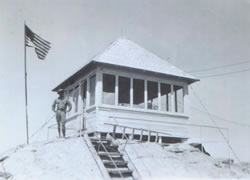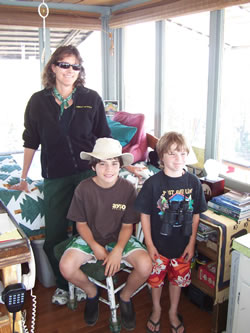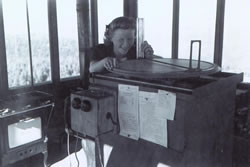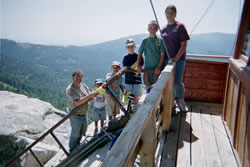
National Fire Plan Success Story
The Evolution of Fire Lookouts in the Sierra: Improved Fire Response through Partnership
Sequoia National Forest and Sequoia and Kings Canyon National Parks, California
National Fire Plan - Partnership
2010

Buck Rock Lookout (1925).

Lookout Kathy Allison with young visitors.

Lea Dotters works the firefinder at Buck Rock (1944).

Visitors enjoy Buck Rock.
For most people, fire lookouts evoke images of rustic buildings perched on lonely outcrops and lookouts calling in fires for immediate suppression.
Lookouts throughout the West are disappearing as the buildings fall into disrepair and modern technology can provide information about fire starts.
However, an effort by the Buck Rock Foundation to keep a handful of lookouts in operation to assist national parks and forests has proven a viable model, even in a vast wilderness area where fires are often monitored instead of suppressed.
The Buck Rock, Park Ridge, and Delilah lookouts, which command views of Sequoia and Kings Canyon National Parks and the Sequoia National Forest and Monument, are now staffed primarily by volunteers in the summer months. As in years past, they track lightning storms and call in fire starts and smoke reports. As always, fires that threaten lives and property are suppressed.
However, the lookouts have proven their value by redefining their role beyond early detection and notification. When fires are managed, the lookouts provide valuable information about the fire through close observation.
When a fire shows sudden growth or when the smoke plume builds or changes color, they pass this valuable information to fire managers. They can relay radio traffic and take weather observations. They are part of the fire response team on which land managers have grown to rely.
What is also clear is that visitors to the parks and forests honor the tradition, the history, of a fire lookout in the American West. Fire lookouts make thousands of visitor contacts every year as people come up to see the view and the lookouts. They educate visitors about wildland fire in the Sierra and what lookouts do today. They keep the tradition alive. This is why visitors can make the trek up to these rustic buildings, built in the 1920s and 1930s, perched on a lonely outcrop, and find a person working at the lookout, as well as an operational lookout.
For more information, see the Buck Rock Foundation website.
Contacts
Deb Schweizer, Fire Education Specialist, Sequoia and Kings Canyon National Parks, (559) 565-3703.
Mary Chislock, Public Affairs Officer, Sequoia National Forest and Giant Sequoia National Monument, (559) 784-1500